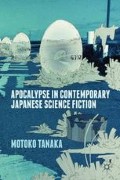Abstract
Two apocalyptic events in 1995—the Kobe Earthquake and the sarin gas attack on the Tokyo subway—revealed not just the fragility of the Japanese infrastructure and emergency system that had previously been thought inviolable, secure and coordinated, but also that human lives can come to a sudden, violent end even in a highly modern society. These revelations led to the manifestation of the uncanny Other within the self and the limitation of the fictional age. We have seen that from the 1970s to the early 1980s, apocalyptic science fiction portrayed the quest for ideals in reality in order to solidify grand narratives and to maintain the concordance of beginning, middle, and end; they strongly reflect the idealistic age, relying on a linear understanding of time. From the mid-1980s, however, apocalyptic fiction shifted to describing ideals being sought in fictional settings; it no longer strove for the recreation of ideals and grand narratives in reality, and instead set them in an explicitly fictive space by introducing multiple linear timelines.
Access this chapter
Tax calculation will be finalised at checkout
Purchases are for personal use only
Preview
Unable to display preview. Download preview PDF.
Notes
Otsuka Eiji and Sasakibara Gō, Kyōyō to shite no manga, anime (Comic Books and Animations as Culture) (Tokyo: Kôdansha, 2001), 80, 189.
Kasai Kiyoshi, “Sekaikei to reigai jōtai” (Sekaikei and the Exceptional Condition), in Shakai wa sonzai shinai: sekaikei bunkaron (There is No Society: the Theory of Sekaikei Culture), ed. Genkai shōsetsu kenkyūjo ( Tokyo: Nan’undō, 2009 ), 21–28.
Uno Tsunehiro, Zero nendai no sōzōryoku ( Imaginations in the 2000s) (Tokyo: Hayakawa shobō, 2008 ), 83.
Takahashi Shin, Saishū heiki kanojo (Saikano: The Last Love Song on This Little Planet), 7 vols. (Tokyo: Shōgakukan, 2000–2001). Manga Saishū heiki kanojo was originally serialized in Shōgakukan’s Big Comic Spirits magazine. Later, the manga story turned into the TV animation in 2002, original video animation in 2005, and the live-action film in 2006.
Akiyama Mizuhito, Iriya no sora, UFO no natsu (Iriya’s Sky, Summer of the UFOs), 4 vols. (Tokyo, Media Works: 2001–2003). The series was once nominated for the Seiun Award, a Japanese science fiction award for the best SF, though it was originally published as light novels targeted at teenagers. Later, it turned into original video animation in 2005, two video games for the Nintendo DS in 2007, and a manga series in the teen boys’ magazine Dengeki Mad in 2007.
Ōsawa Masachi, Fukandsei no jidai ( The Age of Impossibility) (Tokyo: Iwanami shoten, 2008 ), 81–83.
Uno Tsunehiro, Zero nendai no sdzdryoku ( Imagination in the 2000s) (Tokyo: Hayakawa shobō, 2008 ), 83.
Saitō Tamaki, Shakaiteki hikikomori ( Social Withdrawal) (Tokyo: PHP, 1998 ), 3–8.
Genda Yūji, “Jobless Youths and the NEET Problem in Japan,” Social Science Japan Journal 10, 1 (2007): 23–40.
Amae is the word referring to the Japanese psychological construct of passive object love in Freudian terms, typically of the kind between mother and infant. See Doi Takeo, The Anatomy of Dependence, trans. John Bester (Tokyo: Kodansha International, 2001 ) ( Originally published as Amae no kôzô ).
Saitō Tamaki, Shakaiteki hikikomori ( Social Withdrawal) (Tokyo: PHP, 1998 ), 206–207.
Neoteny refers to the retention of juvenile or larval features in adults. A detailed discussion of the relationship between neoteny and humanity can be found in Ashley Montague, Growing Young (Westport, Connecticut: Bergin & Garvey, 1989). The term is often used to refer to Japanese contemporary art and subculture products. Anime such as Astro Boy, Doraemon, and Chibi maruko chan and works by internationally renowned artists Nara Yoshitomo and Murakami Takashi are examples of Japanese cultural neoteny. See further details in
Uchida Mayumi and Kojima Yayoi, ed., Neoteny Japan: Takahashi Collection ( Tokyo: Bijutsu shuppansha, 2008 ).
Mori Hiroshi, Sukai kurora (The Sky Crawlers) (Tokyo: Chūō kōronsha, 2004), 245–246. My translation.
Azuma Hiroki, Kuwontamu famir~zu (The Quantum Families) ( Tokyo: Shichōsha, 2009 ).
Azuma Hiroki, Gémuteki riarizumu no tanjō ( The Birth of Gaming Realism) (Tokyo: Kōdansha, 2007 ), 287.
Copyright information
© 2014 Motoko Tanaka
About this chapter
Cite this chapter
Tanaka, M. (2014). Apocalyptic Science Fiction after 1995—Sekaikei Works. In: Apocalypse in Contemporary Japanese Science Fiction. Palgrave Macmillan, New York. https://doi.org/10.1057/9781137373557_6
Download citation
DOI: https://doi.org/10.1057/9781137373557_6
Publisher Name: Palgrave Macmillan, New York
Print ISBN: 978-1-349-47666-4
Online ISBN: 978-1-137-37355-7
eBook Packages: Palgrave Literature CollectionLiterature, Cultural and Media Studies (R0)

